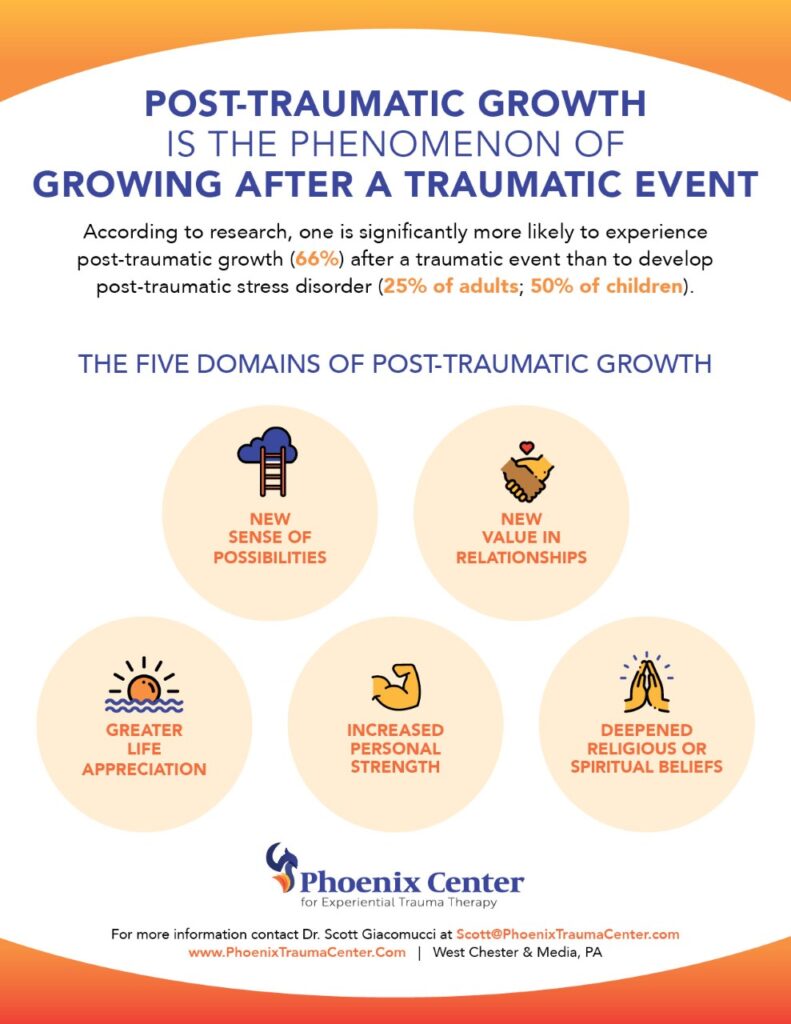Free Downloadable Handout here – https://www.phoenixtraumacenter.com/wp-content/uploads/2021/08/Post-Traumatic-Growth-Handout.pdf
Dr. Scott Giacomucci, DSW, LCSW, BCD, FAAETS, PAT
What is Post Traumatic Growth?
Post traumatic growth (PTG) is the phenomenon of growing after trauma or hardship.
This idea is depicted throughout literature, history, religion, legends, and philosophy. It is certainly not a new idea, though the term “post traumatic growth” and the study of it are new. The fact that growth often occurs as a direct result of difficulties, losses, traumas, and changes is evidenced throughout time. One might even argue that all of our personal strengths are a result of surviving and finding our way through difficulties, struggles, and hardships.
Post-Traumatic Stress Disorder, & Post-Traumatic Growth
A traumatic experience is one that overwhelms our ability to cope and process. One event may be traumatic for one person and not traumatic for another person – it is a subjective experience. An inclusive definition of trauma includes violence, abuse, death/loss, neglect, abandonment, collective trauma, discrimination based on identity, and witnessing trauma. Post-traumatic stress (and PTSD) is characterized by avoidance, numbing, hyperarousal, hypervigilance, dissociation, reexperiencing (flashbacks, nightmares, intrusive images, etc), and negative thoughts, beliefs, and emotions. Many trauma survivors experience aspects of post-traumatic growth and symptoms of post-traumatic stress disorder at the same time.
About 25% of adults that experience a traumatic event will develop Post-Traumatic Stress Disorder (PTSD). However, because of the increased vulnerability of children, childhood trauma is even more impactful resulting in 50% of children developing PTSD symptoms after a traumatic experience. At the same time, Post-Traumatic Growth research found that over 65% of trauma survivors report some type of growth after trauma.
After surviving a traumatic event, you are significantly more likely to experience post-traumatic growth than post-traumatic stress disorder.
Five Common Areas of Post-Traumatic Growth
The literature on post traumatic growth demonstrates five distinct areas that trauma survivors identify as common domains of growth. The five domains of post traumatic growth are:
- A new sense of opportunities after trauma
Trauma and loss shake us to our core and challenge us in ways that we might not have imagined as possible. As a result, many survivors begin to see new possibilities in life and the opening of new doors of opportunity.
- New value in relationships
The process of coping with trauma requires relationships – friends, family, therapists, support groups, etc. As humans, we are neurobiologically wired to regulate our emotions through relationships. The experience of utilizing support after trauma increases these connections and helps us remember how important they are.
- New sense of personal strength
Surviving trauma and asking for help to cope with its aftermath requires incredible strength. Trauma survivors demonstrate extraordinary courage, resilience, vulnerability, trust, hope, and compassion, among other strengths. When an overwhelming event forces us to utilize all the strengths we have (and often develop new ones), we are much more aware of them going forward. “If I survived that trauma, I can survive anything”
- Greater appreciation for life
Trauma, by its nature, threatens our safety, security, and often our lives. Trauma and loss remind us how precious life is and how fragile it can be. It has the ability to help us see the big picture and reconsider our priorities in life.
- Deepening of spiritual/religious views
Because trauma is so often experienced through relationships and involving other human beings, many trauma survivors turn to spirituality or religion for strength, hope, and inspiration. Trauma is an existential crisis that challenges us to make sense of it, often through spiritual, religious, or existential belief systems.
These five domains of post-traumatic growth are sometimes simplified further into three categories: 1) Quality of Life, 2) Perception of self, & 3) Experience of relationships and others
Examples of Post Traumatic Growth
Examples of post traumatic growth exist all around you – and in your own life story. Chances are that you have grown in some way after a difficult experience in your life. Some common examples of post traumatic growth include: valuing relationships more after death; appreciating life more after working through a hardship; helping others that are experiencing something you went through previously; positively changing your perception of yourself after getting through a difficult time; creating change and new possibilities in your life after trauma; starting your own support group; creating changes in your community after a painful experience; advocating for policy changes and social change; etc.
Examples and metaphors of post traumatic growth even exist in nature: the extraordinary pressure that creates diamonds; an irritant in an oyster creates a pearl; volcanos that create new islands; forest fires that give way to new growth; stars in the darkness; sunrise after the dark night; and even plants growing from manure and dirt!
Post-traumatic growth is also something that professionals experience as a direct result of vicarious trauma and working with trauma survivors. For more info an vicarious post-traumatic growth, visit this link – https://www.phoenixtraumacenter.com/vicarious-post-traumatic-growth/

#trauma #traumarecovery #traumahealing #traumatherapy #posttraumaticgrowth #vicariousposttraumaticgrowth #ptsd #ptsdrecovery #ptsdtreatment #experientialtherapy #growthaftertrauma #traumacounseling #traumapsychology


